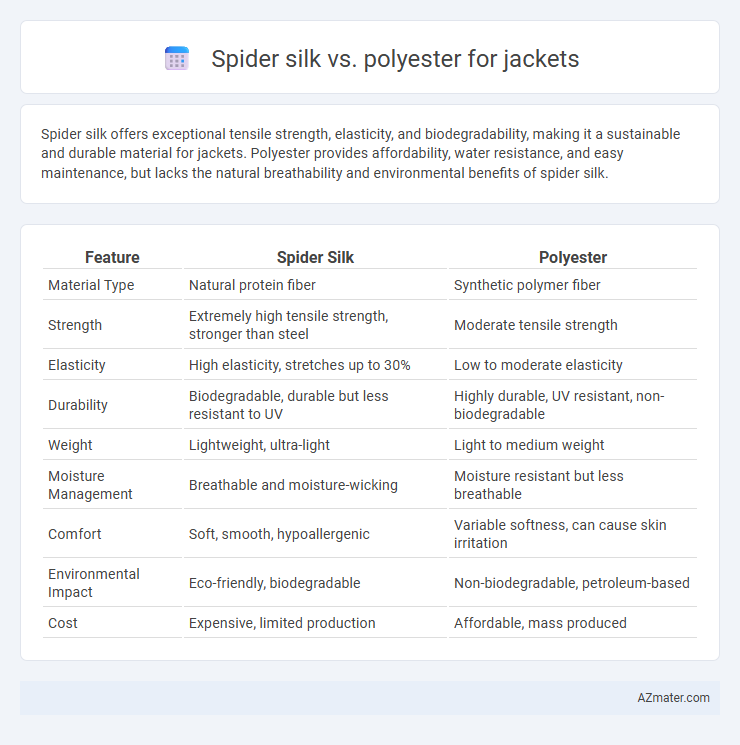Spider silk offers exceptional tensile strength, elasticity, and biodegradability, making it a sustainable and durable material for jackets. Polyester provides affordability, water resistance, and easy maintenance, but lacks the natural breathability and environmental benefits of spider silk.
Table of Comparison
| Feature | Spider Silk | Polyester |
|---|---|---|
| Material Type | Natural protein fiber | Synthetic polymer fiber |
| Strength | Extremely high tensile strength, stronger than steel | Moderate tensile strength |
| Elasticity | High elasticity, stretches up to 30% | Low to moderate elasticity |
| Durability | Biodegradable, durable but less resistant to UV | Highly durable, UV resistant, non-biodegradable |
| Weight | Lightweight, ultra-light | Light to medium weight |
| Moisture Management | Breathable and moisture-wicking | Moisture resistant but less breathable |
| Comfort | Soft, smooth, hypoallergenic | Variable softness, can cause skin irritation |
| Environmental Impact | Eco-friendly, biodegradable | Non-biodegradable, petroleum-based |
| Cost | Expensive, limited production | Affordable, mass produced |
Introduction: The Ultimate Jacket Material Showdown
Spider silk outperforms polyester in strength, elasticity, and sustainability, making it a revolutionary material for jackets. Its natural protein fiber provides exceptional durability and breathability while being lightweight and biodegradable. Polyester, a synthetic polymer, offers affordability and water resistance but lacks the environmental benefits and superior mechanical properties of spider silk.
What is Spider Silk?
Spider silk is a natural protein fiber produced by spiders, renowned for its exceptional tensile strength and elasticity, making it one of the toughest materials known. Compared to polyester, spider silk offers superior breathability, biodegradability, and thermal regulation, enhancing comfort and environmental sustainability in jackets. Advances in bioengineering have enabled the production of synthetic spider silk fibers, combining natural performance benefits with scalable manufacturing for high-performance outerwear.
Understanding Polyester: The Everyday Staple
Polyester, a synthetic polymer derived from petroleum, dominates as a staple fabric in jacket manufacturing due to its durability, affordability, and moisture-wicking properties. Unlike spider silk, which offers exceptional strength and biodegradability, polyester excels in resistance to stretching, shrinking, and abrasion, making it ideal for everyday wear and maintaining shape over time. This fabric's ability to dry quickly and retain color under UV exposure further solidifies polyester's role as the preferred choice for versatile and low-maintenance jackets.
Strength and Durability: Silk vs Polyester
Spider silk exhibits remarkable tensile strength and elasticity, surpassing many synthetic fibers, including polyester, which contributes to superior durability in jacket applications. Polyester, while strong and resistant to abrasion and environmental factors, lacks the natural resilience and flexibility found in spider silk, often leading to decreased longevity under stress. The unique molecular structure of spider silk enables it to absorb and dissipate energy efficiently, making it exceptionally durable compared to the more rigid and less adaptable polyester fibers.
Comfort and Wearability: Which Feels Better?
Spider silk offers superior softness and breathability compared to polyester, providing exceptional comfort during prolonged wear. Its natural moisture-wicking properties help regulate body temperature, reducing sweat buildup and enhancing overall wearability. Polyester, while durable and lightweight, tends to retain heat and moisture, making spider silk the preferred choice for comfort-focused jackets.
Eco-Friendliness and Sustainability
Spider silk offers a highly sustainable alternative to polyester for jackets due to its biodegradable nature and minimal environmental impact during production. Unlike polyester, which is derived from petroleum and contributes to microplastic pollution, spider silk is renewable and decomposes naturally without releasing harmful substances. The use of spider silk reduces reliance on fossil fuels and lowers carbon emissions, promoting eco-friendly fashion choices.
Waterproof and Weather Resistance
Spider silk exhibits superior waterproof properties compared to polyester due to its natural protein structure that repels water while allowing breathability. Polyester jackets are often treated with synthetic coatings to enhance water resistance but can trap moisture and reduce comfort. For weather resistance, spider silk's elasticity and strength offer enhanced durability against wind and rain, whereas polyester's performance depends largely on fabric weight and treatment quality.
Cost and Accessibility
Spider silk jackets offer exceptional strength and lightweight comfort but come with a significantly higher cost due to the complex production process and limited large-scale farming of silk-producing spiders. Polyester jackets are widely accessible and affordable, benefiting from mass manufacturing and synthetic fiber technology that reduces production expenses. The cost-effectiveness and availability of polyester make it the preferred choice for budget-conscious consumers, whereas spider silk remains a premium material in niche markets.
Fashion and Aesthetics Comparison
Spider silk offers an unparalleled natural sheen and smooth texture that enhances the aesthetic appeal of jackets, providing an elegant and luxurious appearance unmatched by synthetic fibers. Polyester, while versatile and available in a wide range of colors and finishes, often lacks the subtle iridescence and tactile richness of spider silk, making it a preferred choice for more utilitarian or casual fashion. The lightweight strength and natural elasticity of spider silk also contribute to a sleek silhouette and refined drape, elevating the overall design and fashion-forward look of jackets.
Future Trends in Jacket Materials
Spider silk, renowned for its exceptional strength-to-weight ratio and biodegradability, is emerging as a revolutionary material in jacket manufacturing, promising enhanced durability and environmental sustainability. Polyester remains dominant due to its affordability and versatile performance, but innovations in bioengineered spider silk fibers aim to surpass polyester's limitations in breathability and ecological impact. Future trends indicate a shift towards hybrid fabrics integrating spider silk with synthetic fibers to create high-performance, eco-friendly jackets optimized for both outdoor protection and sustainable fashion.

Infographic: Spider silk vs Polyester for Jacket
 azmater.com
azmater.com